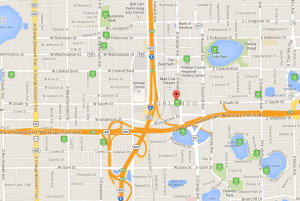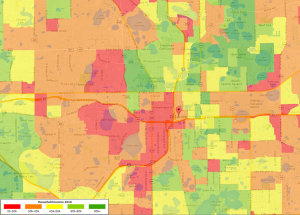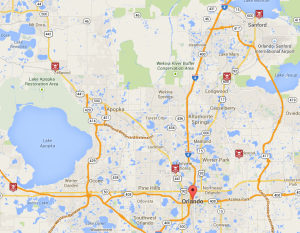The Orlando area has a number of excellent parks that offer a range of activities for the whole family. Parks are an important part of any community since they provide recreational opportunities for residents, act as a gathering place for events and preserve valuable open space. In fact, homes located near well maintained parks typically enjoy higher property values for all of these reasons. In this blog post, we’ll discuss some of the best parks in Orlando, FL and what you can do in them.
events and preserve valuable open space. In fact, homes located near well maintained parks typically enjoy higher property values for all of these reasons. In this blog post, we’ll discuss some of the best parks in Orlando, FL and what you can do in them.
1. Lake Eola Park
Perhaps the best known park in central Florida is Lake Eola Park, located right in downtown Orlando. The park is centered on Lake Eola and boasts a paved 0.87 mile walking/jogging trail circumscribing the lake; it also has a playground and some open fields on its eastern end. The lake itself is spring fed and famous for its swans, which are quite numerous and tame; park visitors often have to walk or jog around the swans, which refuse to give up their spot in the middle of the sidewalk. The walking trail is popular with both residents and tourists since it provides beautiful views of downtown Orlando. In addition to walking and jogging, park visitors can rent a swan-boat for 30 minutes ($15) and paddle around the lake. Lake Eola Park’s central location means it also serves as a venue for many activities. At a bare minimum, the park hosts a farmers’ market each Sunday morning. Many miscellaneous events such as food and wine fests, movie nights and food truck meet-ups also take place in the open space area to the east. In short, Lake Eola offers beautiful views of downtown Orlando, opportunities to exercise and plenty of events at which to eat and shop. If you’ve never been, we recommend you check it out!
2. Wekiva Springs Park
If you’re looking for a park that’s a little more ‘natural’ but still offers a range of civilized amenities, try visiting Wekiva Springs. Wekiva Springs Park is actually located around 10 miles north of downtown Orlando at 1800 Wekiva Cir. Apopka FL 32712. It is expansive – encompassing around 7000 acres of wilderness, but the section that most people visit is centered on Wekiva Springs, which pumps out 42 million gallons of cool, exceptionally clear water each day! The major activities taking place at the park include swimming, canoeing/kayaking, hiking and camping. Wekiva Springs contains an excellent swimming area where fresh spring water ‘boils’ up from a fissure in the limestone bedrock underneath the ground. The depth varies from just a few feet to nearly 6 and the swimming area is separated from the rest of the river, making it a popular spot for parents with young children. Canoeing is probably the most popular activity since canoes and kayaks can be rented cheaply from within the park grounds. The river current is mild (around 2 mph) and a variety of wildlife such as alligators, great blue herons, egrets, foxes, river otters and turtles can be seen. Large cypress trees and other dense plant life make the river quite picturesque. We believe another (very) important point to note is that there is a bar/restaurant named Wekiva Island around a mile downriver of the canoe launch site. It’s an extremely popular spot with locals and offers a variety of food and drink options. It’s family friendly, but does tend to get a bit rowdy as the day goes on (especially on holiday weekends). After you get out of the water to warm up, Wekiva Springs has plenty of spots to grill out, play volleyball and hike.
3. Econlockhatchee Wilderness Area
If nature and solitude are what you want, try visiting the Econ River Wilderness Area in Seminole County. It’s farther out than Wekiva Springs at about 18 miles from downtown Orlando, but it’s worth the trip. The park is really more a nature preserve (it is a state forest) and as such it is absolutely huge at around 9000 acres. Due to its size, it has multiple access points, but one of the more popular is at 1350 Snow Hill Road Geneva, Florida 32732. The park consists of a large forest which contains a navigable river named the Econlockhatchee (usually just abbreviated as the Econ). The area boasts miles of hiking and mountain biking trails. A few of these trails run along the river, creating numerous viewing opportunities. Since there can be fairly dramatic changes in relief along the river bank (by Florida standards) the view is quite scenic in many spots. Assuming the water level is high enough, canoeing along the Econ is also a possibility. The big draw of this park is its size, pristine nature and low usage. It’s possible to hike for many hours without seeing another person. If you’re lucky, you can also catch a glimpse of a gray fox, river otter, deer, wild turkey or bobcat. Birds such as sandhill cranes and bald eagles can also be seen, as can alligators and turtles. If you’re looking for some peace and quiet along with unspoiled scenic beauty, take a trip over to the Econ River Wilderness Area.
There are many other fantastic parks located throughout the Orlando area. You can find the locations of all of the parks and a lot of other information by exploring the MoveMap on MoversAtlas.com!



